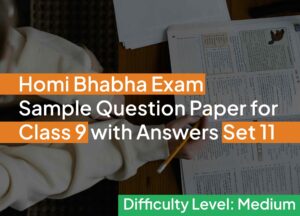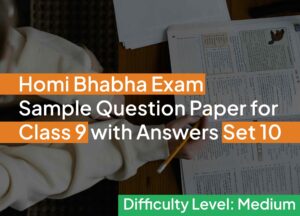Dr. Homi Bhabha Exam sample question paper for Class 9 with our comprehensive set 8 is designed specifically for students following the Maharashtra State Board curriculum, aligning perfectly with the textbooks for 7th, 8th, and 9th standards. This sample question paper is designed to challenge students with in-depth, analytical questions from Maharashtra State Board, CBSE, ICSE, and IB textbooks, covering fundamental science concepts at a high difficulty level.
With questions set at a easy difficulty level, students can effectively enhance their understanding and confidence. Each question aims to challenge students while reinforcing their knowledge, making this resource invaluable preparing for DHBBVS.
1. What is the main function of the roots in plants?
a) Absorb sunlight
b) Absorb water and minerals
c) Produce flowers
d) Perform photosynthesis
Answer: b) Absorb water and minerals
Explanation: The roots of plants absorb water and essential minerals from the soil to support the growth of the plant.
2. Which of the following is a non-renewable source of energy?
a) Wind energy
b) Solar energy
c) Coal
d) Geothermal energy
Answer: c) Coal
Explanation: Coal is a non-renewable source of energy, as it is limited and takes millions of years to form.
3. Which of the following is an example of a physical change?
a) Burning of paper
b) Melting of ice
c) Rusting of iron
d) Baking a cake
Answer: b) Melting of ice
Explanation: Melting of ice is a physical change because it only involves a change in state from solid to liquid without altering the chemical composition.
4. What is the name of the gas that plants release during photosynthesis?
a) Oxygen
b) Carbon dioxide
c) Nitrogen
d) Hydrogen
Answer: a) Oxygen
Explanation: During photosynthesis, plants absorb carbon dioxide and release oxygen as a byproduct.
5. Which of the following is the correct formula for methane?
a) CH₄
b) C₂H₆
c) CH₃OH
d) C₆H₁₂O₆
Answer: a) CH₄
Explanation: Methane is a simple hydrocarbon with the chemical formula CH₄.
6. The process of converting a solid directly into a gas is called:
a) Sublimation
b) Evaporation
c) Condensation
d) Freezing
Answer: a) Sublimation
Explanation: Sublimation is the process in which a solid turns directly into a gas, like dry ice (solid CO₂).
7. Which part of the human body produces insulin?
a) Liver
b) Heart
c) Pancreas
d) Kidney
Answer: c) Pancreas
Explanation: The pancreas produces insulin, a hormone that regulates blood sugar levels in the body.
8. What is the primary component of Earth’s atmosphere?
a) Oxygen
b) Nitrogen
c) Carbon dioxide
d) Water vapor
Answer: b) Nitrogen
Explanation: Nitrogen makes up approximately 78% of Earth’s atmosphere, making it the primary component.
9. Which of these is a correct unit of force?
a) Watt
b) Ampere
c) Newton
d) Meter
Answer: c) Newton
Explanation: The unit of force is Newton (N), named after Sir Isaac Newton.
10. What is the pH of a neutral solution?
a) 1
b) 7
c) 14
d) 0
Answer: b) 7
Explanation: A neutral solution has a pH of 7, indicating it is neither acidic nor basic.
11. Which type of simple machine is a seesaw?
a) Lever
b) Pulley
c) Inclined plane
d) Wheel and axle
Answer: a) Lever
Explanation: A seesaw is a type of lever, where the fulcrum is in the center.
12. Which is the longest bone in the human body?
a) Femur
b) Tibia
c) Humerus
d) Radius
Answer: a) Femur
Explanation: The femur is the longest and strongest bone in the human body, located in the thigh.
13. Which of the following is the symbol for sodium?
a) Na
b) S
c) So
d) N
Answer: a) Na
Explanation: Sodium is represented by the chemical symbol Na, derived from the Latin name ‘Natrium.’
14. What is the SI unit of electric current?
a) Volt
b) Ampere
c) Ohm
d) Watt
Answer: b) Ampere
Explanation: The SI unit of electric current is the Ampere (A).
15. Which of the following is a renewable resource?
a) Coal
b) Natural gas
c) Wind energy
d) Oil
Answer: c) Wind energy
Explanation: Wind energy is a renewable resource as it can be replenished naturally and is not exhausted.
16. What is the chemical formula for water?
a) H₂O
b) H₂SO₄
c) CO₂
d) O₂
Answer: a) H₂O
Explanation: Water consists of two hydrogen atoms and one oxygen atom, represented by H₂O.
17. What type of bond is formed when two atoms share electrons?
a) Ionic bond
b) Covalent bond
c) Hydrogen bond
d) Metallic bond
Answer: b) Covalent bond
Explanation: A covalent bond is formed when two atoms share electrons to achieve a stable electron configuration.
18. Which of the following is a non-metal?
a) Iron
b) Oxygen
c) Copper
d) Magnesium
Answer: b) Oxygen
Explanation: Oxygen is a non-metal, while the other elements listed are metals.
19. The Earth’s magnetic field is generated by the movement of materials in the:
a) Crust
b) Mantle
c) Outer core
d) Inner core
Answer: c) Outer core
Explanation: The movement of molten iron and other materials in the Earth’s outer core generates the planet’s magnetic field.
20. What is the formula for calculating the speed of an object?
a) Speed = Distance × Time
b) Speed = Time / Distance
c) Speed = Distance / Time
d) Speed = Time × Time
Answer: c) Speed = Distance / Time
Explanation: Speed is calculated by dividing the distance traveled by the time taken.
21. What is the boiling point of water at sea level?
a) 50°C
b) 75°C
c) 100°C
d) 150°C
Answer: c) 100°C
Explanation: Water boils at 100°C (212°F) at sea level, under normal atmospheric pressure.
22. Which of the following is an example of a chemical change?
a) Melting ice
b) Burning wood
c) Breaking glass
d) Dissolving salt in water
Answer: b) Burning wood
Explanation: Burning wood results in the formation of new substances (like ash and gases), which is a chemical change.
23. What is the name of the process by which plants lose water vapor through small pores in their leaves?
a) Evaporation
b) Transpiration
c) Absorption
d) Condensation
Answer: b) Transpiration
Explanation: Transpiration is the process by which plants release water vapor through small pores called stomata.
24. Which of the following is the unit of work in the International System of Units (SI)?
a) Joule
b) Watt
c) Ampere
d) Newton
Answer: a) Joule
Explanation: The SI unit of work is the Joule (J), which is equivalent to one Newton-meter.
25. What is the total number of electrons in a neutral carbon atom?
a) 4
b) 6
c) 8
d) 12
Answer: b) 6
Explanation: A neutral carbon atom has 6 electrons, matching the number of protons in its nucleus.
26. Which of the following is a conductor of electricity?
a) Wood
b) Plastic
c) Copper
d) Rubber
Answer: c) Copper
Explanation: Copper is a good conductor of electricity and is widely used in electrical wiring.
27. Which of the following is the chemical symbol for potassium?
a) P
b) K
c) Po
d) Ka
Answer: b) K
Explanation: Potassium is represented by the symbol ‘K’ in the periodic table.
28. Which part of the plant cell is responsible for photosynthesis?
a) Nucleus
b) Mitochondria
c) Chloroplast
d) Endoplasmic Reticulum
Answer: c) Chloroplast
Explanation: Chloroplasts contain chlorophyll, which absorbs sunlight for photosynthesis in plant cells.
29. The energy stored in an object due to its position is called:
a) Kinetic energy
b) Potential energy
c) Heat energy
d) Electrical energy
Answer: b) Potential energy
Explanation: Potential energy is the energy stored in an object due to its position or state.
30. Which of the following is an example of a renewable energy source?
a) Natural gas
b) Solar power
c) Coal
d) Nuclear energy
Answer: b) Solar power
Explanation: Solar power is renewable as it is derived from sunlight, which is naturally replenished.
31. Which of the following is a type of asexual reproduction?
a) Binary fission
b) Pollination
c) Fertilization
d) Cross-fertilization
Answer: a) Binary fission
Explanation: Binary fission is a type of asexual reproduction where an organism divides into two identical daughter cells, like in bacteria.
32. Which of these is the SI unit of power?
a) Joule
b) Watt
c) Volt
d) Ampere
Answer: b) Watt
Explanation: The SI unit of power is the Watt (W), which is defined as one joule per second.
33. Which of the following metals is the lightest?
a) Iron
b) Aluminum
c) Copper
d) Gold
Answer: b) Aluminum
Explanation: Aluminum is the lightest metal among the options, with a relatively low density.
34. Which one of the following is the main component of natural gas?
a) Methane
b) Ethanol
c) Propane
d) Butane
Answer: a) Methane
Explanation: Methane (CH₄) is the primary component of natural gas, making up about 70–90% of it.
35. What is the process by which a liquid changes into a gas?
a) Sublimation
b) Freezing
c) Evaporation
d) Condensation
Answer: c) Evaporation
Explanation: Evaporation is the process in which a liquid turns into gas, typically at the surface, due to heat.
36. What is the function of the stomata in plant leaves?
a) Absorb water
b) Produce food
c) Exchange gases
d) Support the plant
Answer: c) Exchange gases
Explanation: Stomata are small pores on the surface of leaves that allow for gas exchange (oxygen and carbon dioxide) during photosynthesis.
37. Who is known as the father of modern physics?
a) Isaac Newton
b) Albert Einstein
c) Galileo Galilei
d) Nikola Tesla
Answer: b) Albert Einstein
Explanation: Albert Einstein is known for developing the theory of relativity and revolutionizing modern physics.
38. Which scientist discovered the law of gravity?
a) Thomas Edison
b) Albert Einstein
c) Isaac Newton
d) Marie Curie
Answer: c) Isaac Newton
Explanation: Isaac Newton discovered the law of gravity, which explains the force that attracts objects toward the Earth.
39. What is the SI unit of temperature?
a) Celsius
b) Fahrenheit
c) Kelvin
d) Rankine
Answer: c) Kelvin
Explanation: The SI unit for temperature is Kelvin (K), used in scientific measurements.
40. What does DNA stand for?
a) Dynamic Nucleic Acid
b) Deoxyribonucleic Acid
c) Diploid Nucleic Acid
d) Double Nucleic Acid
Answer: b) Deoxyribonucleic Acid
Explanation: DNA stands for Deoxyribonucleic Acid, which carries genetic information in living organisms.
If you find this useful, share it with your friends… so they can join you in preparing for Dr. Homi Bhabha Balvaidnyanik Competition or DHBBVS. Together, you can tackle these questions, discuss the answers, and strengthen your knowledge base.
Start reading, keep preparing and stay focused! Let’s achieve greatness together!




